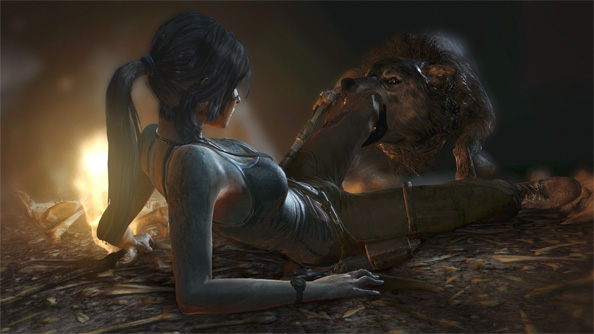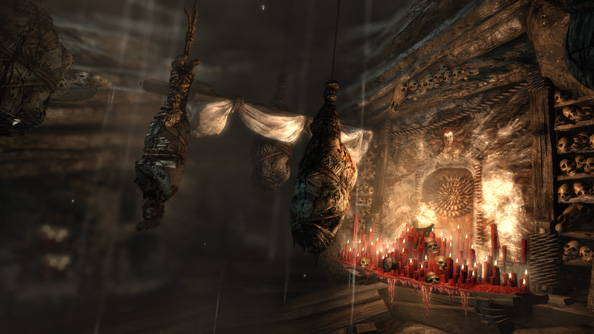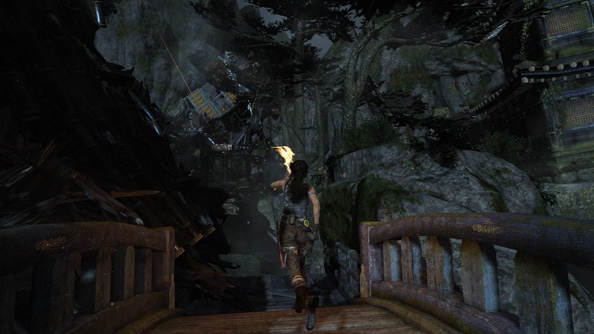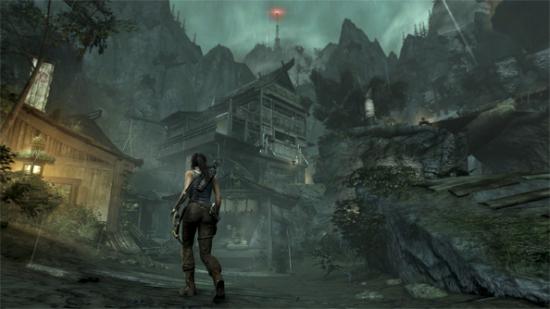Tomb Raider is a game about a woman who keeps standing on rotten planks of wood and falling down. It is a game about a woman who is always sliding on her bum, muddily, confidently towards her next adventure. It is a game about a woman who keeps going into rooms that are not properly affixed to the Earth, and then there is an explosion or a rumble or something, and then the room becomes unmoored and begins to lurch sideways and off the edge of a cliff or a waterfall. It is a very good game, full of exciting things to do with falling, and I like it.
In Tomb Raider you find yourself shipwrecked on a mysterious island full of mysterious tombs and mysterious cultists who’ll chase you around ancient ruins, shooting the faces off giant statues and defiling the sacred resting places of dozens of long-dead royals by chucking sticks of dynamite about. If that bit in Aladdin where the guy working on the sphinx accidentally chisels its nose off made you feel a bit sick, Tomb Raider will send you into a lurching fit of prehistorical sadness, such is the destruction wrought upon your delicate and unique surroundings. Imagine a bomb going off during a taping of Antiques Roadshow and Fiona Bruce gets blasted clear over a marquee and skewered on a branch. That is the reality of Lara Croft’s destructive archaeological efforts. That is Tomb Raider as she is played.
As well as being about wrecking tombs, Tomb Raider is also one of those games that sometimes plays itself while you sit back and watch. During certain sequences it’s not clear whether holding down the ‘go’ key is actually achieving anything, and depending on how intently the game is masturbating you can sometimes let go of the controls entirely and watch Lara automatically backflip over some lava. More often however, all of your button presses are simply interpreted as ‘go forwards’, requiring that you at least be sitting at your desk and paying attention to progress. But that’s okay.

That’s okay because during these moments Tomb Raider is a rollercoaster, a thrilling series of surprising twists and loops and tunnels and screams. Lara escapes toppling towers, scuttles through collapsing caves and across buckling bridges. Walls explode around you, Lara is thrown about as rooms twist and floors crumble away with perfect cinematic timing. The loss of control is countered by your fleeting few panicked reactions, the wheeling camera angles and rousing orchestral tharrumph-a-dumph. It looks and sounds more spectacular than it ever could have done had Crystal Dynamics allowed you, with your poor directorial abilities and penchant for running into walls, complete control over your character during these bits. So that’s okay.
It’s also okay because these cine-chunks are so carefully and sparsely set around the rest of the game, which is a game about shooting bad men, interspersed with the raiding of tombs, which arrive in the form of short, neat physics puzzles. Tomb Raider’s island is optionally open-world, a collection of wide, interconnected hub levels through which you can backtrack and fast-travel in order to collect more XP and salvage — the game’s currency for skills and weapon upgrades — or to find previously inaccessible tombs after having discovered the tools required to reach them.
The game is Zelda-like in its drip-feed of new world-traversing abilities: rope arrows allow you to create your own ziplines, a special climbing axe lets you climb up any walls that have the climbable wall texture on them. By the end of the game you’re basically a tomb raiding Batman, having collected all of these useful toys that Lara will probably accidentally drop down a hole at the beginning of her next game.
You can push forwards and ignore the option to double back and find more tombs. You can also ignore all of the Bear Grylls hunting and survival stuff that the game’s early tutorial and pre-release marketing seems to focus on, as animals are little more than roving, four-legged crates of XP and salvage, and you come across plenty of that stuff simply by carving a direct path through enemies.

Shooting men in their heads feels great too, which is worth pointing out at you do it a whole bunch. Lara’s armoury is whittled all the way down to a snappy handgun, clackety assault rifle, blammo shotgun and stealthy bow, the use of each changing the tempo of gunfights in such a way as to stir up variety as ammo expires and weapons become used out of dire necessity. They all pop satisfyingly, though, and each of the four weapons will get a decent airing around such clever enemies as: man with impenetrable riot shield, man who cannot be hurt by arrows and man who runs right up to you with a machete. The bow is used for stealth kills, allowing you to headshot bad men with arrows in such an order that nobody sees you do it. In that sense it’s a bit like a puzzle. Some of the later skills you unlock allow you to trigger some brutal melee kills too.
It’s worth piling all of your skill points into melee kills, if only because it so messily highlights the wonderful character development of Lara Croft, a woman perpetually bullied by nature and haunted by gravity. She goes from vulnerable, desperate and shivering to a strutting hailstorm of vengeance-fuelled bullet rage, while never losing her defining ability to look at an urn and tell you which Chinese dynasty it’s come from. Looking at the insides of tombs and having Lara say something clever-sounding is a startling mind-snap back to the very first time you played the original Tomb Raider, that sense of visual wonder and awe in your surroundings makes a subtle but very perceptible return. I only wish there were more of it. I’d like Tomb Raider to be one long, interactive, Brian Coxesque anthropological narrative, interrupted only by ledges breaking underfoot and big slides down waterfalls. The sense of constant amazement at the scenery might be partly down to how rarely the game seems to reuse its own art assets: each long-lost burial site and overgrown, statue-studded crevasse looks and feels unique and, with few exceptions, graphically stunning.

It took me about 14 hours to finish Tomb Raider with something around a 60% completion rating, though I might’ve spent a load of time on the menu screen while I was in the shower or making sounds at the cat who lives outside my window. So let’s say 12 hours on an average playthrough, with a few more on top if you decide to go back and find old tombs you missed, which you should. I haven’t played the multiplayer because that ain’t my bag, yo. It runs well enough on my mid-range PC, as long as you turn off fancy hair, but I did have some odd graphical glitching caused by post-processing being switched on, meaning I had to endure a fairly flat looking version of the game for the most part. Driver updates and patching should hopefully fix this right up.
Tomb Raider is the best videogame about shooting things and falling over I’ve played in quite some time, better than at least two of the Uncharted games and better than at least a dozen other Tomb Raider games. It’s refreshingly well-written too, deftly rubbishing the expanding polygonal tits and arse of old Lara Croft to make way for a new character entirely, one who can innately side-step the bullshit two-dimensional machismo that plagues the form to become, by contrast of her own violently framed vulnerabilities, one of the strongest characters in games.Genuinely.
Lara Croft should be celebrated, Tomb Raider should be played and Crystal Dynamics should be rewarded.
